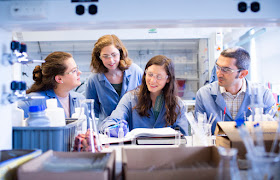Emory chemist Bill Wuest, far right, with some of his graduate students, from left: Erika Csatary, Madeleine Dekarske and Ingrid Wilt. Photo by Ann Watson.
"Saying superbugs, one antibiotic at a time,” is the motto of Bill Wuest’s chemistry lab at Emory University. Wuest (it rhymes with “beast”) leads a team of students fighting drug-resistant bacteria — some of the scariest, most dangerous bugs on the planet.
Most recently, they created new molecules for a study published in PNAS. Their work helped verify how bithionol — a drug used to treat parasitic infections — can weaken the cell membranes of “persister” cells of methicillin-resistant Staphylococcus aureus (MRSA), a deadly staph bacterium. They also synthesized new compounds, to learn more about how bithionol works and enhance its potential for clinical use.
“Just before I entered graduate school, my mother was diagnosed with a severe staph infection,” says Ingrid Wilt, a PhD candidate, explaining what drives her passion to tackle MRSA.
“She was in a hospital in the ICU for about two weeks,” Wilt adds. “Luckily, a last-resort antibiotic worked for her and she’s okay now.”
Click here to read the full story.
Related:
Chemistry students sing their studies, hoping for a good reaction
Brazilian peppertree packs power to knock out antibiotic-resistant bacteria


No comments:
Post a Comment